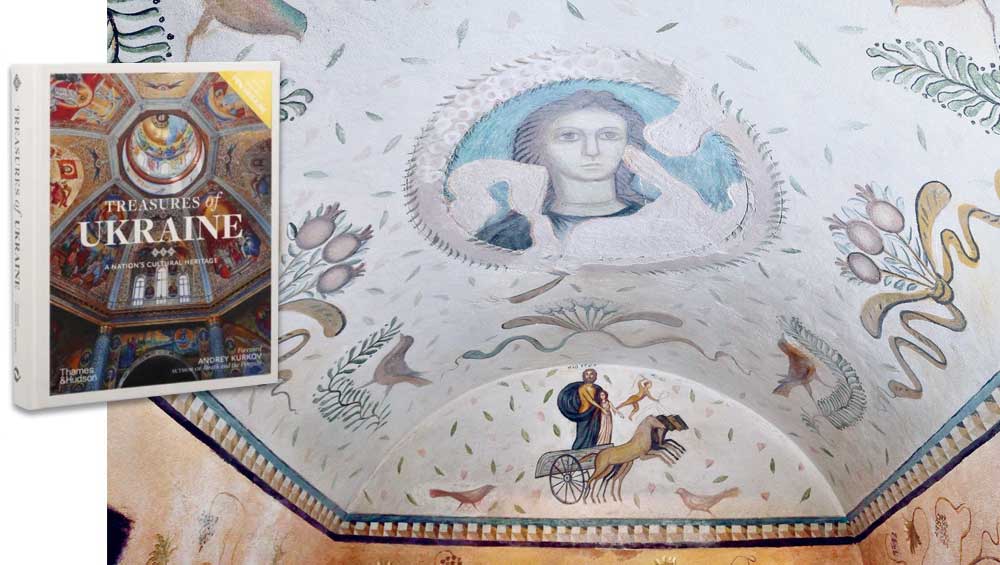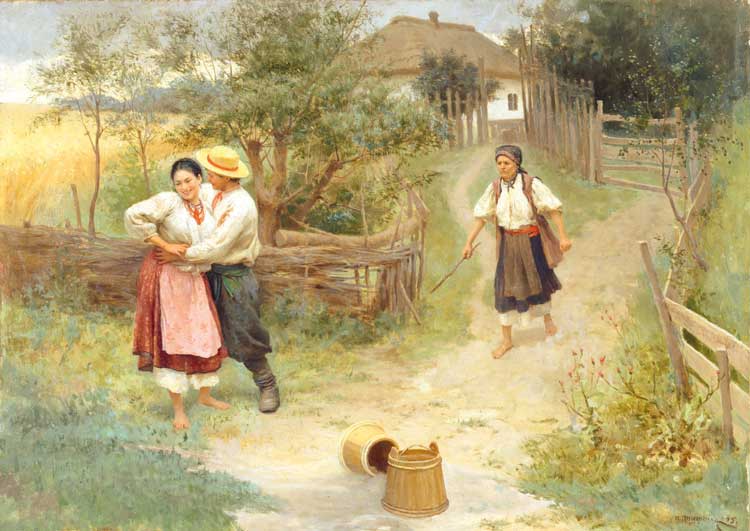
Treasures of Ukraine: A Nation’s Cultural Heritage published by Thames & Hudson. Right: Scene of the abduction of Persephone by Hades in the lunette of the Crypt of Demeter in Kerch, Crimea. Fresco, floral style, early in 1st century CE.
reviewed by NICOLA HOMER
Ukraine’s cultural sites are being hit hard. At the time of writing, Unesco had verified damage to 21 museums since the start of the war with Russia, including the Kyiv Art Gallery and the Khanenko Art Museum. Such places articulate Ukrainian identity, according to the country’s president, Volodymyr Zelenskiy. The importance of cultural preservation becomes evident.
“The war and resultant shelling do not only have a direct impact on museum collections, but also on the capacities to protect and store them. Several other museums have, for instance, seen their facades and windows damaged, which results in degraded conditions,” said a Unesco spokesperson. “Furthermore, the war has displaced numerous cultural heritage and museum professionals and thus reduced the number of qualified professionals capable of properly ensuring the preservation of collections in existing conditions.”

Trypillian ceramics. End of 5th-beginning of 4th millennium BCE. Ceramic. © National Museum of the History of Ukraine, Kyiv.
Treasures of Ukraine is a corrective to the destruction of war. The book offers a unique record of the nation’s cultural heritage at a time when it is at risk of being destroyed: its abstract states that it “reminds us that art and monuments represent powerful sources of collective memory and identity”. The book takes the reader on a journey from the ancient times of the Trypillian and Scythian civilisations to the medieval kingdom of Kyivan Rus and the early state of the Cossack Hetmanate, to the modernist wave of early 20th-century Europe (which brought together artists from different parts of Ukraine, governed by the Austro-Hungarian and the Russian empires), to the post-perestroika generation and contemporary art.

Boris and Hlib, mid-14th century. Tempera on wood, 142.5(h) x 94.3(w) cm. Kyiv Picture Gallery. © Collection of the National Museum 'Kyiv Art Gallery' (the Kyiv National Art Gallery).
This highly readable publication features more than 100 buildings and objects, for example a first-century fresco of the crypt of Demeter in Kerch, described as “a monument of global significance”, and a 14th-century portrait of saints from the ruling dynasty of the Russian royal family, illustrating the Byzantine church style, from the Kyiv Picture Gallery. All proceeds from the book will go to the human rights non-governmental organisation PEN Ukraine. The book states: “A proportion of funds will be diverted to support museums in Ukraine that have sustained damage as a result of Russian bombardment, to assist with construction efforts and to rebuild their collections.”
Treasures of Ukraine has a foreword by the writer Andrey Kurkov, president of PEN Ukraine and the author of the novel Death and the Penguin. In his introduction, he follows the story of nation-building in Ukraine, which has led the country to develop a strong sense of identity, after achieving independence from the Soviet Union in 1991, for example during the Orange Revolution in 2004. He traces the roots of the country’s unique identity further back in time, to the Cossack Hetmanate, a democratic state, which helped to cultivate individualism and citizenship in the country from the 16th century. Yet he explains that Russia has a history of autocratic monarchy, where the tsar was associated with stability and society was characterised by a collective mentality. The tensions of Russian-Ukrainian relations were seen in the Stalin era, at a time of forced agricultural collectivism in Ukraine (known as the bread basket of Europe), which exacerbated the famine of 1932-33 – the Holodomor – in which millions of Ukrainians died. “Today’s brutal invasion is a continuation of Russia’s attempt to subjugate Ukrainian identity,” he says.

Candle of Memory, National Museum of the Holodomor-Genocide, 2008, Kyiv. Ezarubina/123RF.com
While the Candle of Memory stands proud at Kyiv’s National Museum of the Holodomor-Genocide in one image, accompanying this introduction, there is a fitting illustration of A Dove Has Spread Her Wings and Asks for Peace (1982), a vibrant work by the highly regarded Ukrainian folk artist Maria Prymachenko (1909-97), who grew up during the famine. Sadly, 25 of her paintings were destroyed when the Ivankiv Museum, Kyiv region, was hit by a missile in February 2022. And yet with this painting from her significant oeuvre, the book articulates a moral call for action. Kurkov sets out his stall for “teaching Ukrainian history, literature and culture in a way that encourages individual understanding and ownership”. This signposts the scope of a book that educates readers about the nation’s cultural heritage.
Treasures of Ukraine is organised into eight chronological chapters and a narrative on folk art, written by academics and experts: artists, curators and critics. The authors of these chapters are Victoria Burlaka, Diana Klochko, Alisa Lozhkina, Myroslava M Mudrak, Andriy Puchkov, Christian Raffensperger, Oleksandr Soloviev and Maksym Yaremenko. The chapters cover an impressive sweep of history, including prehistoric times, Kyivan Rus, the Grand Duchy of Lithuania, the Baroque era, the 19th century, the avant garde, the Soviet era and contemporary art. Fragments from the past evoke national identity: Scythian gold, Byzantine iconography, the technology of the printing press, and paintings with folkloric themes. An example can be seen in a popular folk painting (1895) by Mykola Pymonenko, a figurative scene, set in a Ukrainian pastoral landscape, in a well-written chapter entitled The Nineteenth Century & The Fin-de-Siècle by Lozhkina, a curator.

Mykola Pymonenko, Stop Fooling Around, 1895. Oil on canvas, 79 x 108 cm. National Art Museum of Ukraine, Kyiv.
Pymonenko was the first teacher of the Soviet Russian avant-garde artist Kazimir Malevich, who founded the 20th-century art movement of suprematism, two years before the Russian Revolution of 1917. Malevich would go on to paint Portrait of the Advanced Worker (1932), later held in the collection of a museum in St Petersburg. This moment signposts how the histories of Ukraine and Russia were closely intertwined. The characterisation of 19th- and early 20th-century artists as having either Ukrainian or Russian origins is fraught with difficulty. Such artists were often hybrid figures, writes Lozhkina in a piece on contested imperial legacies. Consider Arkhyp Kuindzhi, an artist of Greek origin, from Mariupol, who painted illuminated landscapes such as Night on the Don (1882), a cultural treasure rescued from the Kyiv Art Gallery, which is illustrated in the book. In March 2022, Mariupol’s Kuindzhi Art Museum was destroyed in a Russian airstrike. Earlier this year, the Metropolitan Museum in New York classified Kuindzhi as Ukrainian.
One of the most enlightening chapters is Kyivan Rus by Raffensperger, the Kenneth E Wray Chair in the Humanities at Wittenberg University. The professor’s chapter focuses on a region that existed from the late 9th century to the early 13th century. He suggests it has its origins in Scandinavians’ exploration of eastern European river systems. The trade network shows the interconnected nature of this historical state. The author’s style is crisp and clear as he tells the story of the state and its rulers. He charts the extraordinary reach of this region in a golden age, under the rule of Yaroslav (the son of Volodymyr, who established Christianity there) and his wife Ingigerd, a Swedish princess, which “saw Rus stretching to become the largest territorial state in medieval Europe, from the Baltic in the north to the Black Sea in the south; from the frontiers with Poland and Hungary in the west to the Volga in the east. A German chronicler of the time even called Kyiv a ‘rival to the sceptre of Constantinople’”. An image of the Byzantine-style dome of St Sophia Cathedral in Kyiv, a Unesco world heritage site, serves to highlight this observation.
This interconnectivity continues to this day. Konstantin Ashinka, an art historian and curator, and co-editor of In the Eye of the Storm: Modernism in Ukraine, 1900-1930s, which focuses on the three cultural centres of Kyiv, Kharkiv and Odesa, shared expertise to put together the book. I asked Ashinka about the significance of Treasures of Ukraine. He told me: “The publication of the book, on the one hand, is significant and, on the other, proves a sad point. At the beginning of the war, one of my Austrian friends noticed that because of Putin’s aggression, Europeans made an unexpected discovery – they learned that there are museums in Ukraine.”
He added: “I have been following the destruction of the Ukrainian heritage since the beginning of the war. Leafing through the book, I noticed a picture of the nomadic stone stelae installed on the summit of Mount Kremenets in Izyum. During the Russian occupation of Izyum, soldiers destroyed some ancient statues and damaged others. They even used stelae as ‘flagpoles’, attaching Soviet banners with iron wire. This case is not exceptional. Many other monuments reproduced in the book are in danger today. This is the most critical role of the publication – the readership will be aware of the fatal risk for the cultural treasures we are facing today. Of course, Treasures of Ukraine is just the first introduction to the history of Ukrainian art. It is already followed by scholarly publications dedicated to different topics addressed in the book. Treasures of Ukraine became the first swallow of the European discovery of Ukrainian culture. Unfortunately, this discovery was provoked by the war.”
• Treasures of Ukraine: A Nation’s Cultural Heritage, with an introduction by Andrey Kurkov, is published by Thames & Hudson, price £25.
• In The Eye of the Storm: Modernism in Ukraine 1900-1930s is at Thyssen-Bornemisza Museo Nacional in Madrid, Spain, until 2 May 2023. The accompanying publication of the same name, by Konstantin Akinsha, Katia Denysova and Olena Kashuba-Volvach, is published by Thames & Hudsonpublished by Thames & Hudson, price £40.